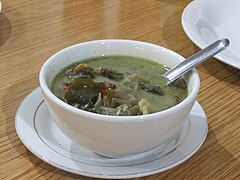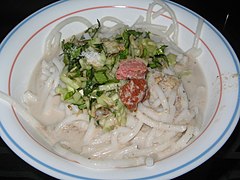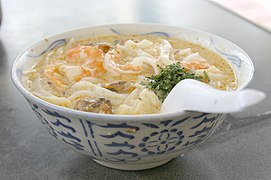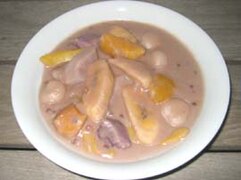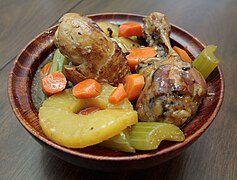Contents
Coconut soup is a fruit soup prepared using coconut milk or coconut fruit as a main ingredient. Many varieties of coconut soups exist in the world, including ginataan, laksa, sayur lodeh, soto, and tom kha kai, and myriad ingredients are used. They can be served hot or cold. While most coconut soups are savoury dishes, some varieties—such as binignit and kolak—are sweet dessert soups.
Overview
Coconut soup is a fruit soup prepared using coconut fruit or coconut milk as a primary ingredient.[1] It can be prepared as a broth-based or cream-based soup.[1][2] The coconut fruit can be sliced, chopped, or shredded.[2] Green coconut fruit from young coconuts can also be used to prepare coconut soup, and coconut water and coconut oil are sometimes used as ingredients.[1] Many various coconut soups exist in the world, with myriad ingredients used. Coconut soup is sometimes prepared in combinations using other ingredients, such as chicken, potato, or curry.[3] It can be served as a hot or cold soup.[4]
By country and region
Caribbean
Sopito is a common fish soup or fish chowder in Aruba and Curaçao of the Lesser Antilles.[5][6][7] The dish uses coconut milk and salt-cured meat as main ingredients.[a] Coconut water is also often used to prepare sopito.[8] Sopita de pisca is a variation that uses tomatoes.[9] Coconut and chayote soup is consumed in some areas of the Caribbean.[10]
-
Jamaican fish and coconut milk soup
China
Sago soup is a Chinese dessert soup prepared using sago starch, which is derived from sago palm pith, coconut milk, and other ingredients.[11][12][13][14] Sago is similar to tapioca, and is produced in pearl form.[12]
Indonesia
Some varieties of soto, an Indonesian soup, are prepared using coconut milk, such as soto ayam and soto betawi.[15] Several Indonesian soups also use coconut milk, such as lontong cap go meh, ketupat sayur, opor and sayur lodeh, a vegetable soup in coconut milk.[16][17]
Palembang's mie celor is noodles in shrimp and coconut soup,[18][19] while laksan is slices of pempek fish surimi served in coconut-based laksa soup.[20]
Sweet coconut soup dessert includes kolak and cendol, popular for iftar during Ramadan.[b][c]
-
Laksan Palembang
Laos
Tom kha kai is a popular dish in Laos.[23]
Malaysia and Singapore
Laksa is a popular noodle dish with many diverse variants, many of which are prepared with coconut milk, noodles, spices, and meats such as chicken, fish, or shrimp.[24][25] Tofu and vegetables are also sometimes used as ingredients.[24][26][27][28]
-
A variant of Malaysian-style curry laksa
-
Kelantanese-style laksa
-
A typical bowl of Singaporean-style laksa
-
Katong laksa, a variant of Singaporean-style laksa
Philippines
In the Philippines, the very diverse class of soups and stews cooked in coconut milk are collectively known as ginataan. They include both savory and dessert dishes.[29][30][31] Savory examples of ginataan soups and stews include ginataang kalabasa, sinilihan, and tiyula itum. Dessert examples include binignit, bilo-bilo, and ginataang mais.[32][33]
Thailand
Thai Khao soi is a noodle soup dish prepared with egg noodles, coconut milk, curry, and meats such as beef and chicken, and served with pickled mustard greens and raw shallots.[34] Red curry is a Thai soup prepared using coconut milk, meats, and red curry as main ingredients.[35] Tom kha kai (Thai coconut soup) is a Thai soup prepared using coconut milk, chicken, mushrooms, chili peppers, galangal, lemongrass, and other ingredients.[23][36] Tom yam kathi is a Thai coconut soup and a variant of tom yum prepared using coconut milk.[37]
See also
- Asian soups
- Chè bà ba – a Vietnamese dessert that includes coconut milk soup as an ingredient
- List of coconut dishes
- List of dishes made using coconut milk
- List of soups
- Mie koclok – An Indonesian chicken noodle soup that is served in coconut milk soup
- Molagoottal – a South Indian stew prepared using coconut and lentils
Notes
- ^ "... sopito (a fish chowder that owes its special flavor to coconut milk — in addition to fish, salt pork or corned ..."[6]
- ^ "Notably, the kolak is served almost exclusively during Ramadan, and can thus be said to be a ritual drink; however, there are ..."[21]
- ^ "Ask around for cendol Temburong – a special provincial brew available only around Ramadan. "[22]
References
- ^ a b c Ganeshram, R. (2016). Cooking with Coconut: 125 Recipes for Healthy Eating; Delicious Uses for Every Form: Oil, Flour, Water, Milk, Cream, Sugar, Dried & Shredded. Storey Publishing, LLC. p. 40. ISBN 978-1-61212-647-0. Retrieved May 30, 2017.
- ^ a b Saffery, D. (2007). The Ghana Cookery Book. Jeppestown Press. p. 43. ISBN 978-0-9553936-6-2. Retrieved 2017-05-30.
- ^ Hood, K.J.M. (2014). Coconut Delights Cookbook: A Collection of Coconut Recipes. Cookbook Delights Series. Whispering Pine Press International, Incorporated. p. 271. ISBN 978-1-59434-294-3. Retrieved 2017-05-30.
- ^ Blanco, Maria; Pendleton, James (2013). The Complete Idiot's Guide to the Coconut Oil Diet. DK Publishing. p. 9. ISBN 978-1-61564-339-4. Retrieved May 30, 2017.
- ^ Houston, L.M. (2005). Food Culture in the Caribbean. Food culture around the world. Greenwood Press. p. 112. ISBN 978-0-313-32764-3. Retrieved May 30, 2017.
- ^ a b Birnbaum, S. (1989). Birnbaum's Caribbean, 1990: Bermuda and the Bahamas. Houghton Mifflin. p. 182. ISBN 978-0-395-51141-1. Retrieved May 30, 2017. (subscription required)
- ^ Philpott, D. (2016). The World of Wine and Food: A Guide to Varieties, Tastes, History, and Pairings. Rowman & Littlefield Publishers. p. 299. ISBN 978-1-4422-6804-3. Retrieved May 30, 2017.
- ^ Porter, D. (1987). Frommer's dollarwise guide to the Caribbean. Frommer/Pasmantier. p. 675. ISBN 978-0-671-54720-2. Retrieved May 30, 2017.
- ^ Porter, D.; Prince, D. (2006). Caribbean For Dummies. --For dummies. Wiley. p. 150. ISBN 978-0-471-96251-9. Retrieved May 30, 2017.
- ^ Philpott, D. (2002). Cayman Islands. Hunter Publishing Landmark Visitors Guides. Landmark. p. 29. ISBN 978-1-84306-037-6. Retrieved May 30, 2017.
- ^ Sanmugan, D. (2016). Mini Delicious Tropical Desserts & Sweets. Tuttle Publishing. p. 48. ISBN 978-1-4629-1901-7. Retrieved May 30, 2017.
- ^ a b Choo, R. (2012). Pan Asian Cookbook – Malaysian Cuisine – Rohana Choo's Kitchen. Rohana Choo's cookbooks. Springwood emedia. p. 39. ISBN 978-1-4761-0905-3. Retrieved May 30, 2017.
- ^ Osbeck, P. (1771). A Voyage to China and the East Indies. p. 72. Retrieved May 30, 2017.
- ^ Dennys, N.B. (1874). The China Review, Or, Notes and Queries on the Far East. "China Mail" Office. p. 53. Retrieved May 30, 2017.
- ^ Kruger, V. (2014). Balinese Food: The Traditional Cuisine & Food Culture of Bali. Tuttle Publishing. p. 162. ISBN 978-1-4629-1423-4. Retrieved May 30, 2017.
- ^ Shurtleff, W.; Aoyagi, A. (1979). The Book of Tempeh. Harper & Row, Publishers. p. 94. ISBN 978-0-06-014009-0. Retrieved May 1, 2017.
- ^ "Sayur Lodeh". Tasty Indonesian Food. Retrieved May 1, 2017.
- ^ Kraig, B.; Sen, C.T. (2013). Street Food Around the World: An Encyclopedia of Food and Culture. ABC-CLIO. p. 184. ISBN 978-1-59884-955-4. Retrieved May 1, 2017.
- ^ "Mie Celor Palembang". 18 November 2013. Archived from the original on 5 November 2016. Retrieved 1 June 2017.
- ^ "Palembang Traditional Food". Sriwijaya Post. Retrieved 1 June 2017.
- ^ Möller, A. (2005). Ramadan in Java: The Joy and Jihad of Ritual Fasting. Lund studies in history of religions. Department of History and Anthropology of Religions, Lund University. p. 292. ISBN 978-91-22-02116-2. Retrieved June 12, 2017.
- ^ Richmond, S. (2010). Malaysia, Singapore & Brunei. Country Guide Series. Lonely Planet. p. 584. ISBN 978-1-74104-887-2. Retrieved June 12, 2017.
- ^ a b Herbst, R.; Herbst, S.T. (2015). The Deluxe Food Lover's Companion, 2nd edition. Barron's Educational Series. p. 985. ISBN 978-1-4380-7621-8. Retrieved May 30, 2017.
- ^ a b Vandersant, L.; Davies, L.; Bonnici, R. (2008). Soup for All Seasons. Aduki Independent Press. p. 20. ISBN 978-0-9803351-4-9. Retrieved May 30, 2017.
- ^ Zimmern, A. (2009). The Bizarre Truth: How I Walked Out the Door Mouth First . . . and Came Back Shaking My Head. Crown/Archetype. p. 135. ISBN 978-0-307-58922-4. Retrieved May 30, 2017.
- ^ Tan, C.B. (1993). Chinese peranakan heritage in Malaysia and Singapore. Fajar Bakti. p. xvi. ISBN 978-967-65-2463-8. Retrieved May 30, 2017.
- ^ Chee-Beng, T. (2012). Chinese Food and Foodways in Southeast Asia and Beyond. SINGAPORE University Press. p. 197. ISBN 978-9971-69-548-4. Retrieved May 30, 2017.
- ^ Koh, J.; D, S.H.P. (2009). Culture and Customs of Singapore and Malaysia. Cultures and Customs of the World. ABC-CLIO. p. 100. ISBN 978-0-313-35116-7. Retrieved May 30, 2017.
- ^ Myke Sarthou (2014). Angelo Comsti (ed.). The Filipino Family Cookbook: Recipes and Stories From Our Home Kitchen. Marshall Cavendish International Asia Pte Ltd. p. 92. ISBN 9789814634946.
- ^ IBP, ed. (2007). Philippines Country Study Guide. International Business Publications. p. 112. ISBN 9781433039706.
- ^ Linda Civitello (2007). Cuisine and Culture: A History of Food and People. John Wiley & Sons. p. 240. ISBN 9780471741725.
- ^ Boquet, Y. (2017). The Philippine Archipelago. Springer Geography. Springer International Publishing. p. 230. ISBN 978-3-319-51926-5. Retrieved May 30, 2017.
- ^ Virmani, I.K. (1991). Home Chefs of the World: Rice and Rice-based Recipes. International Rice Research Institute. p. 49. ISBN 978-971-22-0023-6. Retrieved May 30, 2017.
- ^ Walters, A.V. (2014). The Foodspotting Field Guide. Chronicle Books. p. pt39. ISBN 978-1-4521-3008-8. Retrieved June 1, 2017.
- ^ Jacobsen, N.; Salguero, C.P. (2014). Thai Herbal Medicine: Traditional Recipes for Health and Harmony. Findhorn Press. p. 46. ISBN 978-1-84409-884-2. Retrieved May 30, 2017.
- ^ Punyaratabandhu, L. (2014). Simple Thai Food: Classic Recipes from the Thai Home Kitchen. Potter/TenSpeed/Harmony. p. 162. ISBN 978-1-60774-524-2. Retrieved May 30, 2017.
- ^ Sriangura, Vanniya (January 27, 2017). "Nothing But the Best". Bangkok Post. Retrieved May 30, 2017.
External links
 Media related to Coconut milk soups at Wikimedia Commons
Media related to Coconut milk soups at Wikimedia Commons



